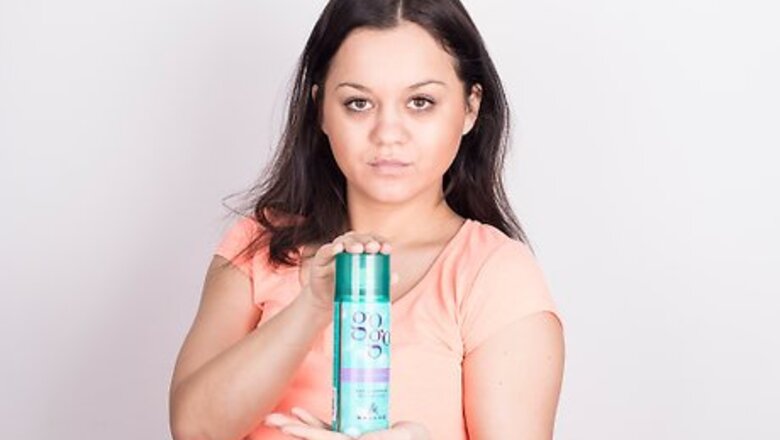
views
Shampooing and Conditioning Your Hair
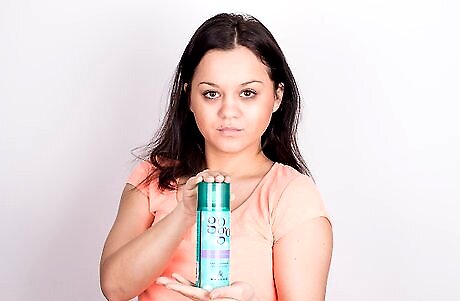
Shampoo less frequently. The naturals oils produced by your scalp help to combat frizzy, dry hair. Shampoo strips these oils from your hair. Fight frizz by decreasing the number of times you shampoo your tresses each week. After rinsing your hair with warm water, apply a sulfate-free, moisturizing shampoo to your roots. As you lather up the shampoo, avoid applying the product to the shaft and ends of your hair. Rinse out the product with warm water. Always use a moisturizing shampoo. If you have fine hair, try lathering up every other day. If you have have thick hair, try going two to three days between washes. If you have excessively dry, fragile, and or porous hair, shampoo your locks every one to two weeks. Instead of using a traditional shampoo, consider experimenting with the no-poo or co-wash products. These shampoo free products will cleanse your scalp and moisturize your hair without drying out your tresses.

Condition your hair. When dry, porous hair takes in moisture from the air, the hair shaft swells and becomes frizzy. You can prevent this from happening by deep conditioning your hair. After shampooing your hair, coat the hair shafts, never the roots, with a protein-rich deep conditioner and let it sit for five minutes. Once the deep conditioner has penetrated your hair, rinse it out with cool water to seal the cuticle.
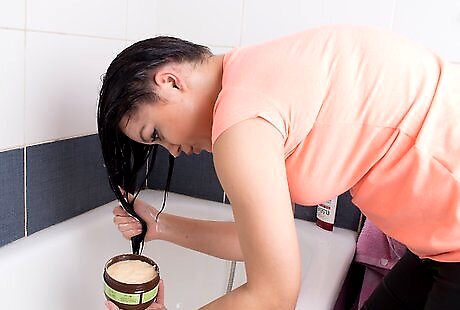
Apply conditioning treatments regularly. Hair masks and hot oil treatments are an excellent way to infuse your dry locks with extra moisture and strengthen the cuticle. Once every one to two weeks, coat your hair with the restorative mask or hot oil treatment of your choice. When applying a hair mask, coat your hair with the product and then cover your head with a shower cap. Let the product to sit for the time allotted in the product’s instructions. Rinse out your hair thoroughly. Search for treatments that contain keratin, protein and natural oils. Avoid products that include parabens and sulfate. When applying a hot oil treatment, coat your freshly washed and towel dried hair with the product. Place a shower cap over your head and then apply heat via the sun, a blow dryer, or a hot towel. Allow your hair to cool to room temperature and then rinse with cold water.
Drying and Styling Your Hair
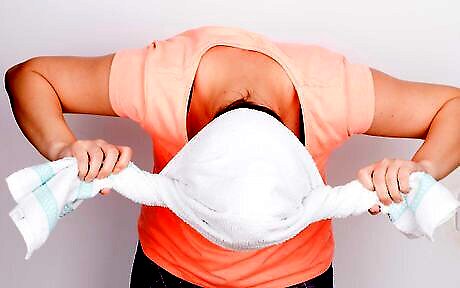
Remove excess water from your hair. After showering, people commonly use a bath towel to squeeze the excess water from their hair. Rubbing a towel vigorously against frizz-prone hair, however, further damages the cuticle and increases your susceptibility to frizz. Instead of using a common bath towel, gently pat and squeeze water from your hair with a microfiber towel or cotton shirt.

Apply a frizz-taming product to your damp hair. Silicone-based hair serums are ideal for people with dry, frizzy hair. These products will protect your tresses from the sun and humidity. Prior to blow drying, apply the serum or cream to your damp hair. If you have thin hair, avoid serums that are "extra-moisturizing." The additional oil may weigh down your hair. Search for a product that contains Indian Alma oil. If you have thick, wavy hair, purchase a serum that claims to be "extra-moisturizing." Look for products that contain Alma or Argan oils. If your hair is coarse and curly, you need a product that will moisturize and curl your hair. Try using a curl cream to control your frizz.

Blow dry your hair. While heat from a blow dryer can further damage dry hair, the moisture your hair absorbs while air drying causes unwanted frizz. Following a shower, never let your hair air dry for too long. Apply an anti-frizz shine serum to your wet locks and blow dry your hair as soon as possible to lay down the cuticle. Invest in a high-quality, ionic ceramic blow dryer. Ionic blow dryers help to press down the cuticle and keep frizz-inducing moisture out. Set your blow dryer to a medium or low heat setting. High heat can cause the cuticle to swell. When drying your hair, use a round natural bristle brush, such as a boar bristles, to help smooth and distribute the natural oils of your hair. If you have curly hair, use the diffuser tool and your fingers. It will help your curls dry evenly.
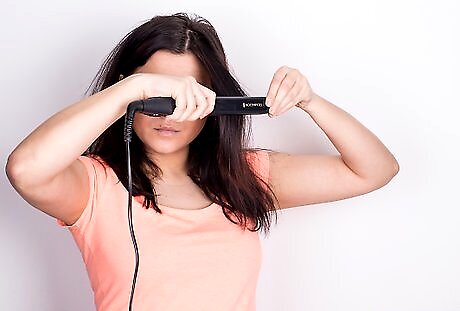
Curl or straighten your hair with care. Excessive exposure to heat can further damage your dry, frizzy hair. When you use a curling iron or straightener, take a few additional measures to protect your tresses. Limit your use of heated tools. Always apply a heat-protecting serum to your hair prior to curling or straightening it. Set your heated tool to a temperature between 350℉ to 450℉. Applying such a high heat to your hair seems counter-intuitive, but it actually significantly reduces your hair’s exposure to heated tools. The higher the temp, the fewer times you have to go over a section of hair to achieve the desired results. Invest in high-quality tools.
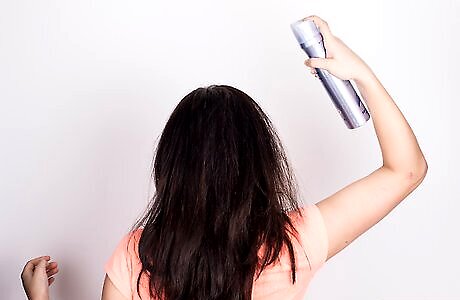
Keep flyaways at bay. People with frizzy hair tend to have flyaways, little pieces of hair that stick straight-up. After styling your hair, lightly spray your locks with an alcohol-free hairspray. The hairspray with set your style in place and prevent flyaways. If you have kinky, wavy, or curly hair, spray the hair spray directly into your palm. Rub your hands together and then pat the areas of your hair that are prone to flyaways.
Preventing Further Damage
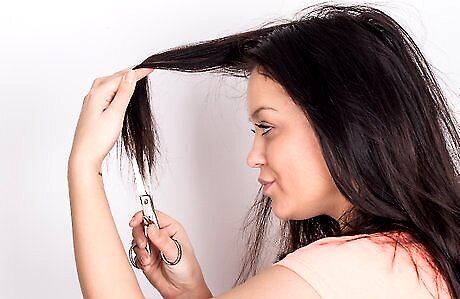
Get regular trims. Split ends increase the presence of frizz. To help keep frizz and split ends at bay, schedule a trim every eight weeks. Frequent trims will increase the health of your hair by preventing new splits and breaks from occurring.
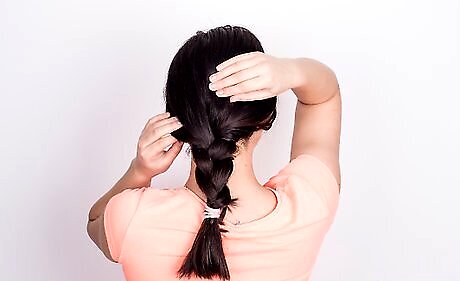
Protect your hair at night. Throughout the night, your hair can come into contact with fabrics that roughen up the cuticle and cause frizz. This form of damage is completely preventable and avoidable. Swap your cotton or synthetic-blend pillow case with a silk or satin pillowcase. You may also choose to sleep with a silk scarf wrapped around your head.
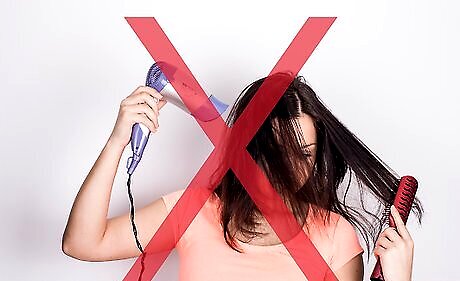
Avoid brushing dry hair. Once your hair dries, you should not run a brush through your tresses. When you brush dry hair, you disrupt the cuticle and stretch out the strand. Both can lead to breakage and frizz. If you must brush your frizz-prone hair, wet your fingers and comb through your locks gently.

Avoid over processing your hair. Frizz-prone hair is fragile and must be treated with care. Harsh chemical treatments, such as relaxers, perms, and hair dyes, can remove the moisture from your already dry hair. When your hair lacks moisture, it becomes brittle and prone to breakage and frizz.











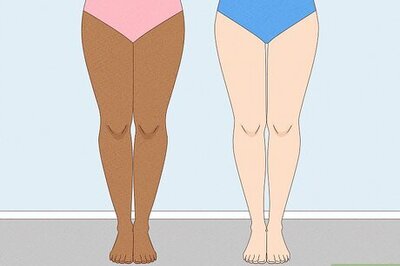








Comments
0 comment